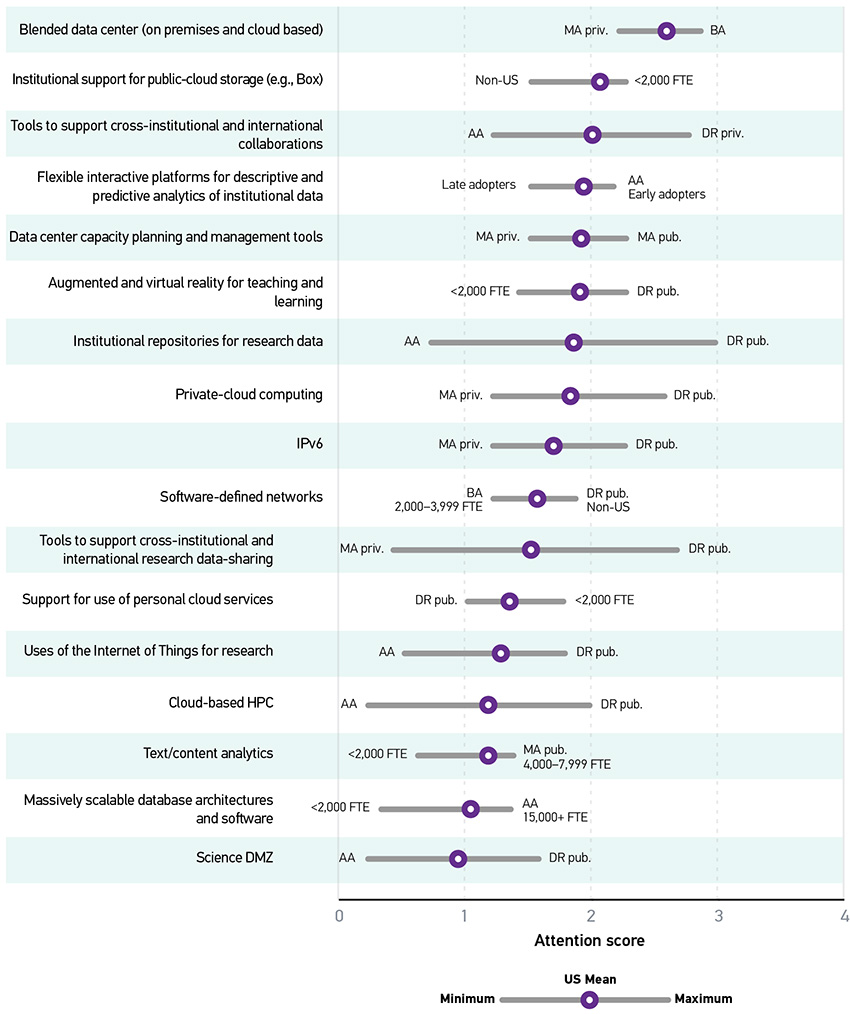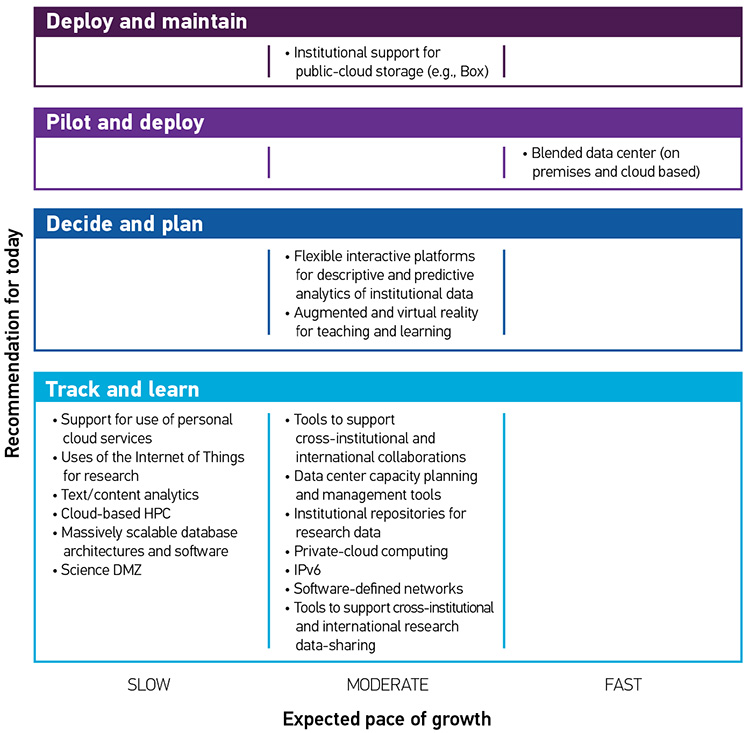Research and Scholarship
For many colleges and universities, research is a crucial part of the institutional mission. Today's research is data intensive and collaborative and is enabled by campus technology services. The 2018 EDUCAUSE Top 10 IT Issues list features items that are directly applicable to institutional research and scholarship activities. For example, issue #4, data-enabled institutional culture, and issue #8, data management and governance (tie) and digital integrations (tie), are critically important for institutional research activities. The most influential trend in this domain, institution-wide data management and integrations, hints at the important relationship between institutional IT services and research and scholarship. Yet, the EDUCAUSE Center for Analysis and Research (ECAR) 2017 Faculty and Information Technology research found that institutions and their IT organizations may have some room for improvement in this regard. Only 53% of faculty are satisfied with their institution's technological support for their research needs, and only 45% are generally satisfied with the provision of research-computing technologies.
This section covers the 11 trends and 17 technologies included in the research and scholarship domain. While one technology in this domain, blended data center (on premises and cloud based), is on the 2018 Top 10 Strategic Technologies list (spot #7), most institutions are just tracking the research and scholarship technologies listed in this section. Technology is integral to today's institutional research and scholarship activities, with ample room for growth and opportunity.
Trends
Included in this domain:
- Applications and implications of artificial intelligence to higher education
- Blending of roles and blurring of boundaries between IT and academic/administrative areas
- Cross-institutional and international scholarly and research collaborations
- Cross-institutional partnerships and consortia
- Digital enterprise strategy
- Digitization of scholarly and research data
- Institution-wide data management and integrations
- Internet of Things
- IT as an agent of institutional transformation and innovation
- Ubiquitous digital sources and streams
- Vendor relationships that bypass IT
Understand how the most influential trends are affecting your institution.
Zero trends are influential at 61% or more of colleges and universities.
Review the trends that are taking hold and address them at your institution.
Two trends are influential at 41–60% of institutions (listed below from highest to lowest level of influence):
- Institution-wide data management and integrations
- IT as an agent of institutional transformation and innovation
Understand these trends, and consider their possible role at your institution.
The influence of seven trends is limited to 21–40% of institutions. Higher education is monitoring these trends with respect to emerging IT strategy and the deployment of research and scholarship strategic technologies (listed below from highest to lowest level of influence):
- Blending of roles and blurring of boundaries between IT and academic/administrative areas
- Cross-institutional partnerships and consortia
- Digital enterprise strategy
- Vendor relationships that bypass IT
- Digitization of scholarly and research data
- Cross-institutional and international scholarly and research collaborations
- Ubiquitous digital sources and streams
The remaining two trends were of limited impact in our research:
- Internet of Things
- Applications and implications of artificial intelligence to higher education
Technologies
Included in this domain:
- Augmented and virtual reality for teaching and learning
- Blended data center (on premises and cloud based)
- Cloud-based HPC
- Data center capacity planning and management tools
- Flexible interactive platforms for descriptive and predictive analytics of institutional data
- Institutional repositories for research data
- Institutional support for public-cloud storage (e.g., Box)
- IPv6
- Massively scalable database architectures and software
- Private-cloud computing
- Science DMZ
- Software-defined networks
- Support for use of personal cloud services
- Text/content analytics
- Tools to support cross-institutional and international collaborations
- Tools to support cross-institutional and international research data-sharing
- Uses of the Internet of Things for research
Complete initial deployment and maintain these technologies.
Our research shows that half of institutions are planning to deploy and maintain one research and scholarship strategic technology.
- Institutional support for public-cloud storage (e.g., Box)
Pilot and start deploying these technologies.
At this time, a majority of institutions are planning to pilot and deploy one research and scholarship strategic technology:
- Blended data center (on premises and cloud based)
Decide when these technologies fit your strategy, and start planning.
A majority of institutions are watching these two research and scholarship strategic technologies carefully, deciding and planning for potential future deployment (listed below from highest to lowest attention):
- Flexible interactive platforms for descriptive and predictive analytics of institutional data
- Augmented and virtual reality for teaching and learning
Learn about and track these technologies.
About one-half to three-quarters of institutions are tracking and learning about the following 13 research and scholarship strategic technologies (listed below from highest to lowest attention):
- Tools to support cross-institutional and international collaborations
- Data center capacity planning and management tools
- Institutional repositories for research data
- Private-cloud computing
- IPv6
- Software-defined networks
- Tools to support cross-institutional and international research data-sharing
- Support for use of personal cloud services
- Uses of the Internet of Things for research
- Text/content analytics
- Cloud-based HPC
- Massively scalable database architectures and software
- Science DMZ
Peer Institution Approach to Strategic Technologies
Understanding what peer institutions (both current and aspirational) are doing can help you gauge whether your institution's current approach is on track or might warrant reconsideration. Some technologies are more relevant for some types of institutions than others. We looked at broad demographic categories, including Carnegie class, institutional size, and approach to technology adoption and found differences in attention score based on those factors. (See the methodology section for explanation of our attention score calculation.) In figure 9, the US mean is the average attention score for an item from all US respondents. The minimums and maximums are the lowest and highest average attention scores among all groups within the categories of Carnegie class, institution size, and timing of technology adoption, with labels indicating which group or groups returned that score. In the event of a tie, all tied groups are represented.

Preparing for the Future
Understanding the technologies that are most relevant for your institution and how fast a certain strategic technology may be growing is critical to institutional IT strategy. We estimated the pace of growth based on the percentage of institutions we predict will implement each technology over the next five years (by 2023). Figure 10 positions each technology in one of 12 cells based on institutional intentions (the "recommendation for today") and the expected pace of growth of that technology. Reflecting what was noted above, the figure shows that that most of the technologies we tracked are still being explored—rather than deployed—by most institutions.
